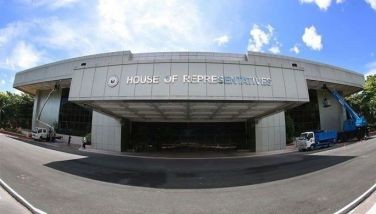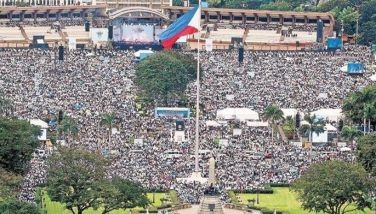Water

June 10, 2006 | 12:00am
The wars of the future, resource forecasters say, will be over water.
With the global population continuing its growth, potable water sources are becoming scarce. Control over major rivers that cut across national boundaries will be the source of diplomatic tension.
If, for instance, one upriver nation decides to build a dam to generate power and produce irrigation, that could cut off the supply of downriver nations. To avert spiraling tensions, it has become important for nations with shared water sources to establish conventions for joint exploitation.
Water wars might seem extreme. But today, many urban populations are facing the specter of water scarcity.
In the Philippines, Metropolitan Manila and Metropolitan Cebu are extremely vulnerable to water shortages. The availability of water is often the most overlooked factor in the planning of major property and infrastructure projects.
We have a National Water Resources Board (NWRB). Its role is to allocate the use of available water and anticipate future supply for future needs.
The existence of such a water authority has not made our situation any more reassuring.
For instance, the NWRB has prohibited the use of deep water wells in the Metro Manila area. The reason for this is that our aquifers have fallen below sea level and are therefore in a critical state. At that level, sea water begins to seep in and the wells bring forth saline water. The land deteriorates into subsidence and ground water is contaminated.
Earlier this month, however, the NWRB Director stated in effect that deep wells will be tolerated in Las Pinas, Paranaque and Muntinlupa because Maynilad Water Services does not have enough water to supply subdivisions in the area. But what happens to our critically depleted aquifers then?
The NWRB likewise acknowledged that several large malls in other areas of the metropolis were illegally operating deep wells. But what is being done to stop them?
At present, 97 percent of the Manila area’s potable water comes from the Angat Dam. During droughts, water is denied irrigation so that urban faucets do not run dry. It is always a political choice between dehydrating farms or dehydrating a politically powerful urban constituency. The latter always wins.
This year, the Angat Dam will be closed down for refitting. Many of its channels need to be cleared. Where will Metro Manila get its water in the meantime?
Not from Laguna de Bay, which has been kept brackish to appease the fishing communities around it. In a classic case of bureaucratic short-sightedness, the work on the Liban Dam in Tanay was not completed in the late eighties because Manila still had ample water supplies.
The Umiray river project, which would divert water from Quezon to the Angat Dam has yet to be completed. Even if work is rushed to complete this connection, what happens if the Angat Dam needs to be closed down for repairs?
If the El Niño weather phenomenon becomes severe this year, water levels at the Angat Dam might plunge. The past few weeks, water levels at this vital source has been gradually declining.
The water situation in the National Capital Region could become quite severe in the near future.
Only the abandoned Wawa Dam could provide early relief from a looming water crisis that could reach explosive proportions very soon. The Lorenzo Ruiz Builders and Developers Group Inc. has offered to rehabilitate the Wawa Dam at no cost to government and supply more than 1.5 million cubic meters of water to the Balara filters.
The NWRB, however, has continued to ignore the offer of a private developer to do so. It has cited, among others, the fact that numerous poultry farms and piggeries in the river feeding into Wawa Dam has polluted the water from this source. Also, Wawa Dam lies along the Marikina fault line and with earthquakes anticipated in the near future, further investments in this source could be futile.
On the other hand, however, Wawa Dam is the only additional source of fresh water available to the Manila area. Rehabilitating the Dam could alleviate the flooding that hits the Marikina area during the rainy season. Today, millions of cubic meters of fresh water flow uselessly into the bay.
It seems that, facing the imminent threat of serious water shortages in the metropolitan area, we should either begin working hard to protect the water flowing into Wawa Dam and rehabilitate that facility or learn to do rain-dancing.
The Liban river project will involve overwhelming investments estimated at about $2 billion which we will have to borrow. Tens of thousands of squatters in the watershed areas will have to be relocated. A huge pile of right-of-way issues will have to be cleared.
It will take at least a decade to get this source going. In the meantime, how will the Manila area and the Calabarzon region, with their rapidly growing populations, be supplied with fresh water?
Apart from tolerating more and more deep wells puncturing our aquifers and drying up our farmlands, what plan does the NWRB have in hand to deal strategically with the looming water crisis?
We have seen none. Worse, we have seen an abundance of bureaucratic inertia – the tendency to stare at a problem that seems too large to do anything about it.
This large urban tangle we call the National Capital Region is not sitting on a volcano. But it might as well be.
The water is running out quickly. The population is growing rapidly. The farmlands and the subdivisions are fighting for their share of a depleted good.
And the NWRB is pooh-poohing every proposed solution to contain what little of the flowing groundwater we have left and use every possible source to reinforce our rapidly disappearing fresh water supply.
With the global population continuing its growth, potable water sources are becoming scarce. Control over major rivers that cut across national boundaries will be the source of diplomatic tension.
If, for instance, one upriver nation decides to build a dam to generate power and produce irrigation, that could cut off the supply of downriver nations. To avert spiraling tensions, it has become important for nations with shared water sources to establish conventions for joint exploitation.
Water wars might seem extreme. But today, many urban populations are facing the specter of water scarcity.
In the Philippines, Metropolitan Manila and Metropolitan Cebu are extremely vulnerable to water shortages. The availability of water is often the most overlooked factor in the planning of major property and infrastructure projects.
We have a National Water Resources Board (NWRB). Its role is to allocate the use of available water and anticipate future supply for future needs.
The existence of such a water authority has not made our situation any more reassuring.
For instance, the NWRB has prohibited the use of deep water wells in the Metro Manila area. The reason for this is that our aquifers have fallen below sea level and are therefore in a critical state. At that level, sea water begins to seep in and the wells bring forth saline water. The land deteriorates into subsidence and ground water is contaminated.
Earlier this month, however, the NWRB Director stated in effect that deep wells will be tolerated in Las Pinas, Paranaque and Muntinlupa because Maynilad Water Services does not have enough water to supply subdivisions in the area. But what happens to our critically depleted aquifers then?
The NWRB likewise acknowledged that several large malls in other areas of the metropolis were illegally operating deep wells. But what is being done to stop them?
At present, 97 percent of the Manila area’s potable water comes from the Angat Dam. During droughts, water is denied irrigation so that urban faucets do not run dry. It is always a political choice between dehydrating farms or dehydrating a politically powerful urban constituency. The latter always wins.
This year, the Angat Dam will be closed down for refitting. Many of its channels need to be cleared. Where will Metro Manila get its water in the meantime?
Not from Laguna de Bay, which has been kept brackish to appease the fishing communities around it. In a classic case of bureaucratic short-sightedness, the work on the Liban Dam in Tanay was not completed in the late eighties because Manila still had ample water supplies.
The Umiray river project, which would divert water from Quezon to the Angat Dam has yet to be completed. Even if work is rushed to complete this connection, what happens if the Angat Dam needs to be closed down for repairs?
If the El Niño weather phenomenon becomes severe this year, water levels at the Angat Dam might plunge. The past few weeks, water levels at this vital source has been gradually declining.
The water situation in the National Capital Region could become quite severe in the near future.
Only the abandoned Wawa Dam could provide early relief from a looming water crisis that could reach explosive proportions very soon. The Lorenzo Ruiz Builders and Developers Group Inc. has offered to rehabilitate the Wawa Dam at no cost to government and supply more than 1.5 million cubic meters of water to the Balara filters.
The NWRB, however, has continued to ignore the offer of a private developer to do so. It has cited, among others, the fact that numerous poultry farms and piggeries in the river feeding into Wawa Dam has polluted the water from this source. Also, Wawa Dam lies along the Marikina fault line and with earthquakes anticipated in the near future, further investments in this source could be futile.
On the other hand, however, Wawa Dam is the only additional source of fresh water available to the Manila area. Rehabilitating the Dam could alleviate the flooding that hits the Marikina area during the rainy season. Today, millions of cubic meters of fresh water flow uselessly into the bay.
It seems that, facing the imminent threat of serious water shortages in the metropolitan area, we should either begin working hard to protect the water flowing into Wawa Dam and rehabilitate that facility or learn to do rain-dancing.
The Liban river project will involve overwhelming investments estimated at about $2 billion which we will have to borrow. Tens of thousands of squatters in the watershed areas will have to be relocated. A huge pile of right-of-way issues will have to be cleared.
It will take at least a decade to get this source going. In the meantime, how will the Manila area and the Calabarzon region, with their rapidly growing populations, be supplied with fresh water?
Apart from tolerating more and more deep wells puncturing our aquifers and drying up our farmlands, what plan does the NWRB have in hand to deal strategically with the looming water crisis?
We have seen none. Worse, we have seen an abundance of bureaucratic inertia – the tendency to stare at a problem that seems too large to do anything about it.
This large urban tangle we call the National Capital Region is not sitting on a volcano. But it might as well be.
The water is running out quickly. The population is growing rapidly. The farmlands and the subdivisions are fighting for their share of a depleted good.
And the NWRB is pooh-poohing every proposed solution to contain what little of the flowing groundwater we have left and use every possible source to reinforce our rapidly disappearing fresh water supply.
BrandSpace Articles
<
>
- Latest
- Trending
Trending
Latest




























